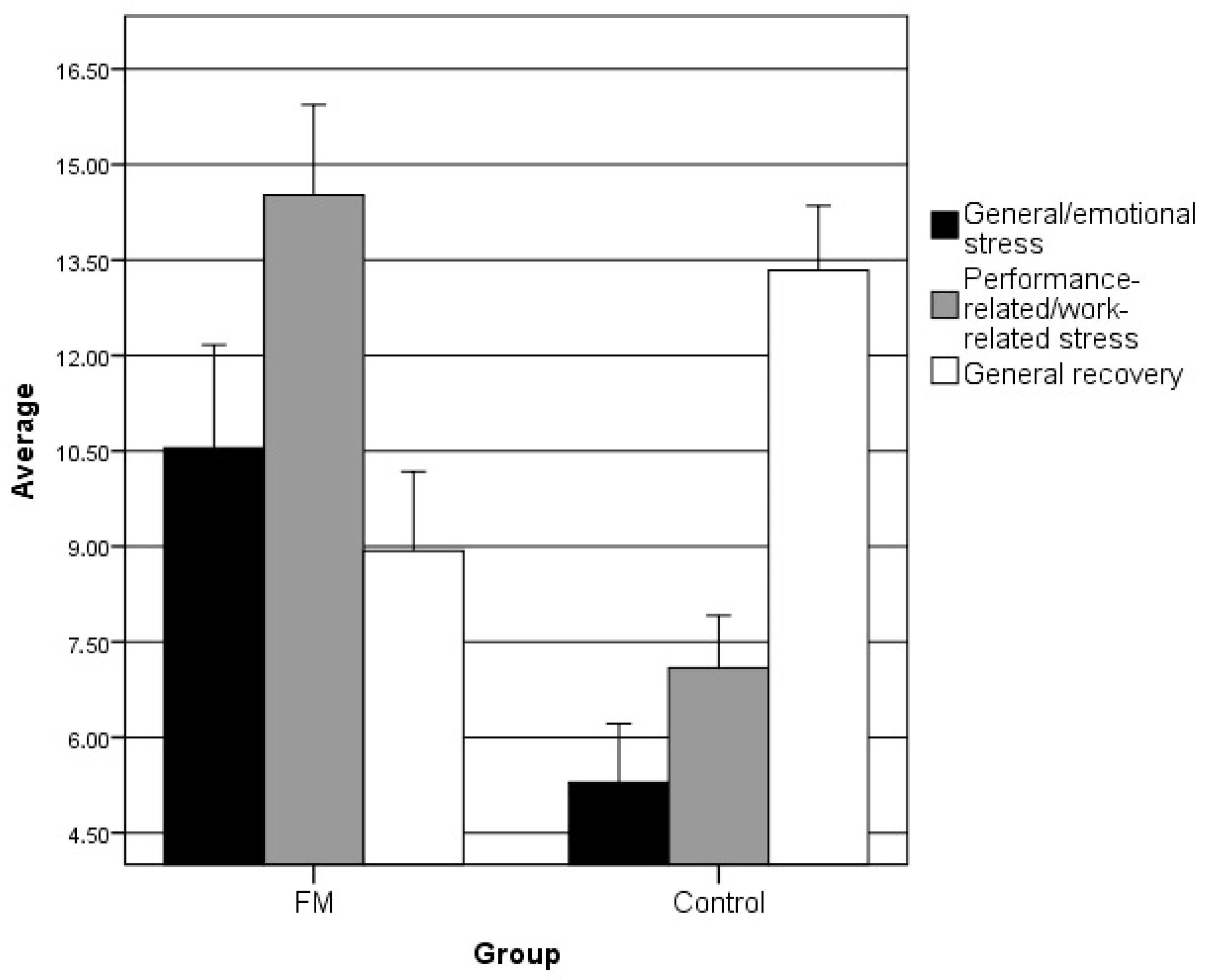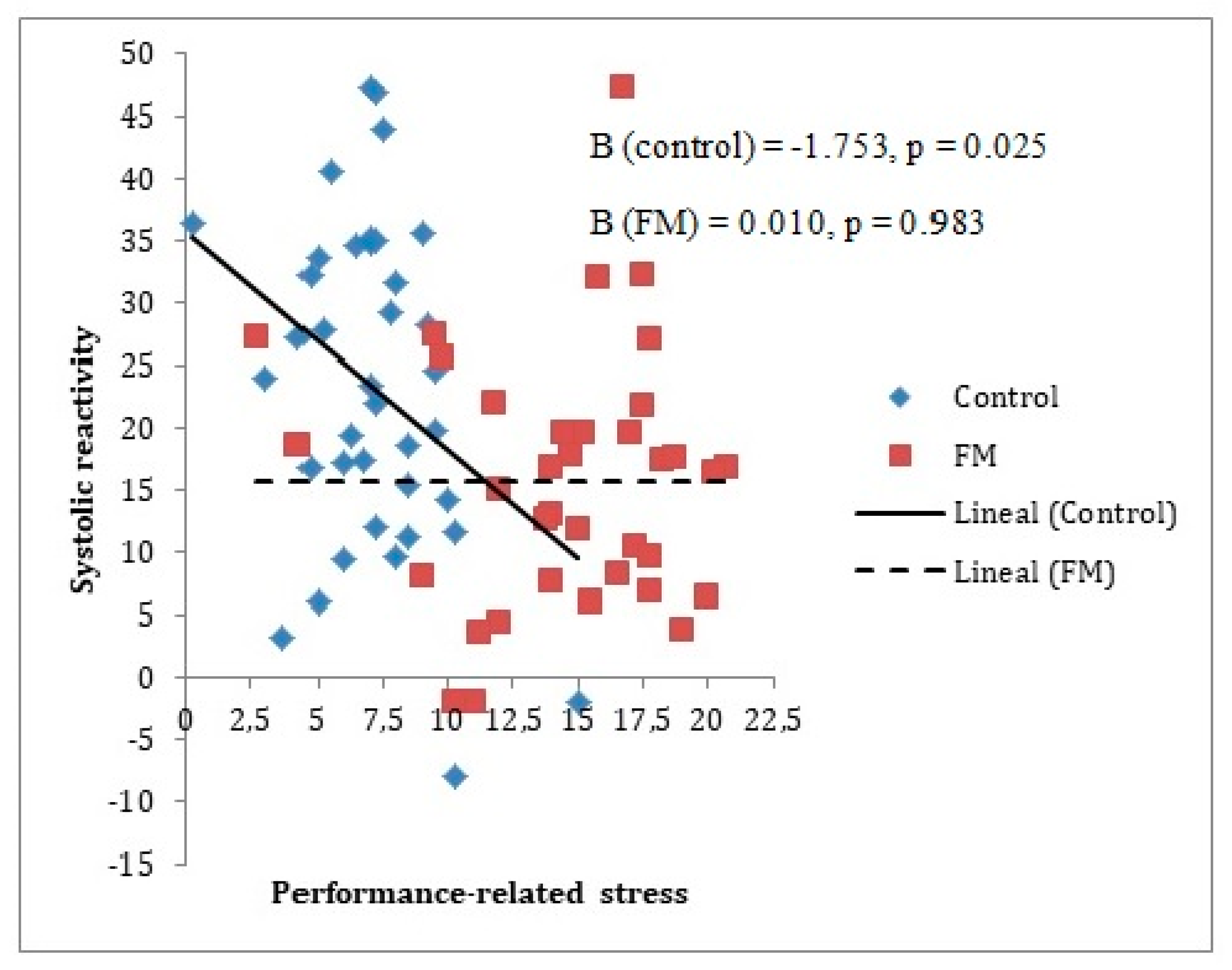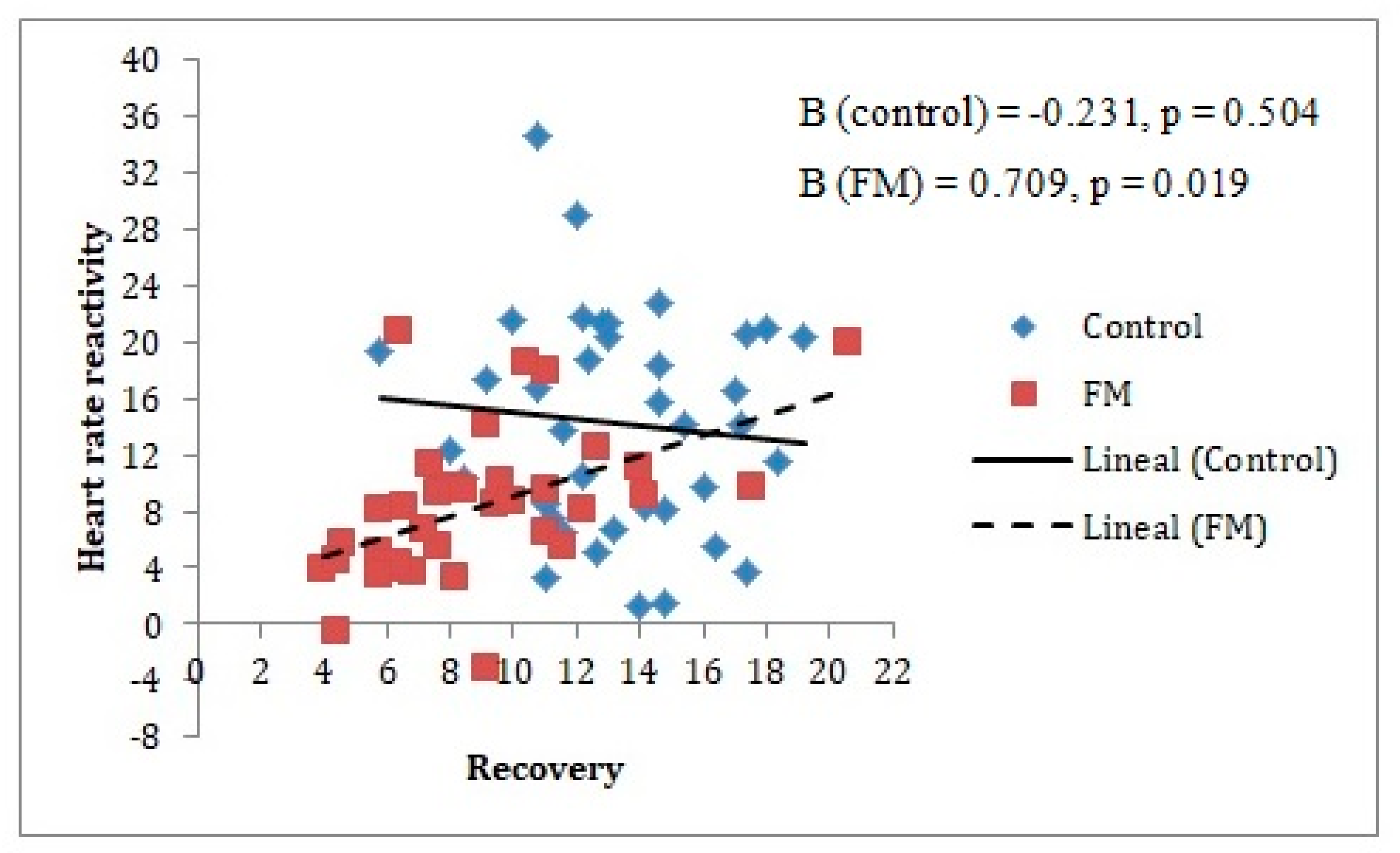Stress-Recovery State in Fibromyalgia Patients and Healthy People. Relationship with the Cardiovascular Response to Stress in Laboratory Conditions
Abstract
1. Introduction
2. Materials and Methods
2.1. Participants
2.2. Questionnaire Measures
2.3. Body Mass Index
2.4. Cardiovascular Recording
2.5. Stress Task: Mental Arithmetic with Harassment
2.6. Procedure
2.7. Statistical Analysis
2.7.1. Preliminary Analyses
2.7.2. Cardiovascular Responses to the Stressor Task
2.7.3. Influence of Stress-Recovery Processes on the Cardiovascular Response
3. Results
3.1. Preliminary Analyses
3.2. Cardiovascular Responses to the Stressor Task
3.3. The Group as a Moderating Factor in the Relationship between Stress-Recovery Processes and Cardiovascular Response
4. Discussion
5. Conclusions
Author Contributions
Funding
Acknowledgments
Conflicts of Interest
References
- Kallus, W.K. Impact of Recovery in Different Areas of Application. In Enchancing Recovery: Preventing Underperfomance in Athletes; Kellmann, M., Ed.; Human Kinetics: Champaign, IL, USA, 2002; pp. 283–300. [Google Scholar]
- Secades, G.; Barquín, R.; Vega, D.L.; Márquez, R. Resiliencia y Recuperación-Estrés En Deportistas de Competición Resilience and Recovery-Stress in Competitive Athletes Resiliência e Recuperação-Estresse Em Atletas de Competição. Cuad. Psicol. Deporte 2017, 17, 73–80. [Google Scholar]
- Kellmann, M. Preventing Overtraining in Athletes in High-Intensity Sports and Stress/Recovery Monitoring. Scand. J. Med. Sci. Sports 2010, 20, 95–102. [Google Scholar] [CrossRef] [PubMed]
- Wright, B.J.; O’brien, S.; Hazi, A.; Kent, S. Increased Systolic Blood Pressure Reactivity to Acute Stress Is Related with Better Self-Reported Health. Sci. Rep. 2014, 4, 6882. [Google Scholar] [CrossRef]
- Thieme, K.; Turk, D.C.; Gracely, R.H.; Maixner, W.; Flor, H. The Relationship among Psychological and Psychophysiological Characteristics of Fibromyalgia Patients. J. Pain 2015, 16, 186–196. [Google Scholar] [CrossRef] [PubMed]
- Heidari, J.; Mierswa, T.; Hasenbring, M.; Kleinert, J.; Levenig, C.; Belz, J.; Kellmann, M. Recovery-Stress Patterns and Low Back Pain: Differences in Pain Intensity and Disability. Musculoskelet. Care 2018, 16, 18–25. [Google Scholar] [CrossRef]
- Cohen, H.; Neumann, L.; Kotler, M.; Buskila, D. Autonomic Nervous System Derangement in Fibromyalgia Syndrome and Related Disorders. Isr. Med. Assoc. J. 2001, 3, 755–760. [Google Scholar]
- Meeus, M.; Goubert, D.; De Backer, F.; Struyf, F.; Hermans, L.; Coppieters, I.; De Wandele, I.; Da Silva, H.; Calders, P. Heart Rate Variability in Patients with Fibromyalgia and Patients with Chronic Fatigue Syndrome: A Systematic Review. Semin. Arthritis Rheum. 2013, 43, 279–287. [Google Scholar] [CrossRef]
- Häuser, W.; Kosseva, M.; Üceyler, N.; Klose, P.; Sommer, C. Emotional, Physical, and Sexual Abuse in Fibromyalgia Syndrome: A Systematic Review with Meta-Analysis. Arthritis Care Res. 2011, 63, 808–820. [Google Scholar] [CrossRef]
- Bojner-Horwitz, E.; Theorell, T.; Anderberg, U. Dance/movement therapy and changes in stress-related hormones: A study of fibromyalgia patients with video-interpretation. Arts Psychother. 2003, 30, 255–264. [Google Scholar] [CrossRef]
- Wolfe, F.; Smythe, H.A.; Yunus, M.B.; Bennett, R.M.; Bombardier, C.; Goldenberg, D.L.; Tugwell, P.; Campbell, S.M.; Abeles, M.; Clark, P. The American College of Rheumatology 1990 Criteria for the Classification of Fibromyalgia. Report of the Multicenter Criteria Committee. Arthritis Rheum. 1990, 33, 160–172. [Google Scholar] [CrossRef]
- Spindelegger, C.J.; Papageorgiou, K.; Grohmann, R.; Engel, R.; Greil, W.; Konstantinidis, A.; Agelink, M.W.; Bleich, S.; Ruether, E.; Toto, S.; et al. Cardiovascular Adverse Reactions during Antidepressant Treatment: A Drug Surveillance Report of German-Speaking Countries Between 1993 and 2010. Int. J. Neuropsychopharmacol. 2015, 18, 1–9. [Google Scholar] [CrossRef]
- Cohen, J. Statistical Power Analysis for the Behavioral Sciences, 2nd ed.; Lawrence Earlbaum Associates: Hillsdale, NJ, USA, 1988. [Google Scholar]
- Dworkin, R.H.; Turk, D.C.; Farrar, J.T.; Haythornthwaite, J.A.; Jensen, M.P.; Katz, N.P.; Kerns, R.D.; Stucki, G.; Allen, R.R.; Bellamy, N.; et al. Core Outcome Measures for Chronic Pain Clinical Trials: IMMPACT Recommendations. Pain 2005, 113, 9–19. [Google Scholar] [CrossRef]
- Bernstein, D.; Fink, L. Manual for the Childhood Trauma Questionnaire; The Psychological Corporation: New York, NY, USA, 1998. [Google Scholar]
- Nijenhuis, E.R.S.; Van der Hart, O.; Kruger, K. The Psychometric Characteristics of the Traumatic Experiences Checklist (TEC): First Findings among Psychiatric Outpatients. Clin. Psychol. Psychother. 2002, 9, 200–210. [Google Scholar] [CrossRef]
- DeLongis, A.; Folkman, S.; Lazarus, R.S. The Impact of Daily Stress on Health and Mood: Psychological and Social Resources as Mediators. J. Pers. Soc. Psychol. 1988, 54, 486–495. [Google Scholar] [CrossRef] [PubMed]
- Sarason, I.G.; Johnson, J.H.; Siegel, J.M. Assessing the Impact of Life Changes: Development of the Life Experiences Survey. J. Consult. Clin. Psychol. 1978, 46, 932–946. [Google Scholar] [CrossRef] [PubMed]
- Aitken, R.C. Measurement of Feelings Using Visual Analogue Scales. Proc. R. Soc. Med. 1969, 62, 989–993. [Google Scholar]
- Lesage, F.X.; Berjot, S.; Deschamps, F. Clinical Stress Assessment Using a Visual Analogue Scale. Occup. Med. 2012, 62, 600–605. [Google Scholar] [CrossRef] [PubMed]
- Gortner, S.R.; Rankin, S.H.; Wolfe, M.M. Elders’ Recovery from Cardiac Surgery. Prog. Cardiovasc. Nurs. 1988, 3, 54–61. [Google Scholar]
- Kallus, W.K. Der Erholungs-Belastungs-Fragebogen (EBF) [The Recovery-Stress Questionnaire]; Swets & Zeitlinger: Frankfurt, Germany, 1995. [Google Scholar]
- Cairo, E.; García, F.E.Y.; Vancol, R. Consistencia de La Versión Española Del Cuestionario de Estrés- Recuperación (RESTQ 76 Sport), En Deportistas Cubanos. Av. Psicol. Deport. Iberoamérica 2012, 1, 31–40. [Google Scholar]
- Lazarus, R.S. Psychological Stress and the Coping Process; McGraw-Hill: New York, NY, USA, 1966. [Google Scholar]
- Kallus, W.; Kellmann, M. The Recovery-Stress Questionnaires: User Manual; Kallus, K.W., Kellmann, M., Eds.; Pearson Assessment & Information GmbH: Frankfurt, Germany, 2016. [Google Scholar]
- Parati, G.; Casadei, R.; Groppelli, A.; Di Rienzo, M.; Mancia, G. Comparison of Finger and Intra-Arterial Blood Pressure Monitoring at Rest and during Laboratory Testing. Hypertens 1989, 13, 647–655. [Google Scholar] [CrossRef]
- Gerin, W.; Pieper, C.; Pickering, T.G. Measurement Reliability of Cardiovascular Reactivity Change Scores: A Comparison of Intermittent and Continuous Methods of Assessment. J. Psychosom. Res. 1993, 37, 493–501. [Google Scholar] [CrossRef]
- Janssen, S.A.; Spinhoven, P.; Brosschot, J.F. Experimentally Induced Anger, Cardiovascular Reactivity, and Pain Sensitivity. J. Psychosom. Res. 2001, 51, 479–485. [Google Scholar] [CrossRef]
- Glynn, L.M.; Christenfeld, N.; Gerin, W. The Role of Rumination in Recovery from Reactivity: Cardiovascular Consequences of Emotional States. Psychosom. Med. 2002, 64, 714–726. [Google Scholar] [PubMed]
- Radstaak, M.; Geurts, S.A.E.; Brosschot, J.F.; Cillessen, A.H.N.; Kompier, M.A.J. The Role of Affect and Rumination in Cardiovascular Recovery from Stress. Int. J. Psychophysiol. 2011, 81, 237–244. [Google Scholar] [CrossRef] [PubMed]
- Jennings, J.R.; Kamarck, T.; Stewart, C.; Eddy, M.; Johnson, P. Alternate Cardiovascular Baseline Assessment Techniques: Vanilla or Resting Baseline. Psychophysiology 2007, 29, 742–750. [Google Scholar] [CrossRef]
- Hayes, A.F.; Little, T.D. Introduction to Mediation, Moderation, and Conditional Process Analysis: A Regression-Based Approach; The Guilford Press: New York, NY, USA, 2018. [Google Scholar]
- Llabre, M.M.; Spitzer, S.B.; Saab, P.G.; Ironson, G.H.; Schneiderman, N. The Reliability and Specificity of Delta Versus Residualized Change as Measures of Cardiovascular Reactivity to Behavioral Challenges. Psychophysiology 1991, 28, 701–711. [Google Scholar] [CrossRef]
- Buijs, R.M. The Autonomic Nervous System. In Handbook of Clinical Neurology; Elsevier: Amsterdam, The Netherlands, 2013; Volume 117, pp. 1–11. [Google Scholar] [CrossRef]
- Japundžić-Žigon, N. Vasopressin and Oxytocin in Control of the Cardiovascular System. Curr. Neuropharmacol. 2013, 11, 218–230. [Google Scholar] [CrossRef]
- Mendelson, N.; Gontmacher, B.; Vodonos, A.; Novack, V.; Abu-AjAj, M.; Wolak, A.; Shalev, H.; Wolak, T. Benzodiazepine Consumption Is Associated with Lower Blood Pressure in Ambulatory Blood Pressure Monitoring (ABPM): Retrospective Analysis of 4938 ABPMs. Am. J. Hypertens. 2018, 31, 431–437. [Google Scholar] [CrossRef]
- Wilens, T.E.; Biederman, J.; Baldessarini, R.J.; Geller, B.; Schleifer, D.; Spencer, T.J.; Birmaher, B.; Goldblatt, A. Cardiovascular Effects of Therapeutic Doses of Tricyclic Antidepressants in Children and Adolescents. J. Am. Acad. Child Adolesc. Psychiatry 1996, 35, 1491–1501. [Google Scholar] [CrossRef]
- Zanstra, Y.J.; Johnston, D.W. Cardiovascular Reactivity in Real Life Settings: Measurement, Mechanisms and Meaning. Biol. Psychol. 2011, 86, 98–105. [Google Scholar] [CrossRef]
- Salomon, K.; Bylsma, L.M.; White, K.E.; Panaite, V.; Rottenberg, J. Is Blunted Cardiovascular Reactivity in Depression Mood-State Dependent? A Comparison of Major Depressive Disorder Remitted Depression and Healthy Controls. Int. J. Psychophysiol. 2013, 90, 50–57. [Google Scholar] [CrossRef] [PubMed]
- Lyon, P.; Cohen, M.; Quintner, J. An Evolutionary Stress-Response Hypothesis for Chronic Widespread Pain (Fibromyalgia Syndrome). Pain Med. 2011, 12, 1167–1178. [Google Scholar] [CrossRef] [PubMed]
- Bradley, L.A. Pathophysiologic Mechanisms of Fibromyalgia and Its Related Disorders. J. Clin. Psychiatry 2008, 69 (Suppl. 2), 6–13. [Google Scholar]
- Turk, D.; Sherman, J. Treatment of Patients with Fibromyalgia Syndrome. In Psychological Approaches to Pain Management; Turk, D., Gatchel, J., Eds.; Guilford Press: New York, NY, USA, 2002; pp. 390–416. [Google Scholar]
- Williams, D. Cogntive and Behavioral Approaches to Chronic Pain. In Fibromyalgia & Other Central Pain Syndromes; Wallace, D., Clauw, D.J., Eds.; Lippincott Williams & Wilkins: Philadelphia, PA, USA, 2005; pp. 343–352. [Google Scholar]
- Smith, M.T.; Haythornthwaite, J.A. How Do Sleep Disturbance and Chronic Pain Inter-Relate? Insights from the Longitudinal and Cognitive-Behavioral Clinical Trials Literature. Sleep Med. Rev. 2004, 8, 119–132. [Google Scholar] [CrossRef]
- Cully, J.; Teten, A. A Therapist’s Guide to Brief Cognitive Behavioral Therapy; Department of Veterans Affairs South Central MIRECC: Houston, TX, USA, 2008.




| Fibromyalgia | Controls | U Mann-Whitney | |||||
|---|---|---|---|---|---|---|---|
| Mean | SD | Median | Mean | SD | Median | ||
| Severity of Childhood Abuse and Neglect (CTQ) | 49.95 | 17.24 | 46 | 41.21 | 11.51 | 38.5 | 440 ** |
| Potentially Traumatizing Experiences (TEC) | |||||||
| Total Presence | 7.03 | 4.36 | 7 | 3.76 | 2.93 | 3 | 358.500 *** |
| Total Severity | 3.78 | 3.24 | 3 | 1.74 | 1.84 | 1 | 382.500 ** |
| Hassles and Uplifts (HSUP) | |||||||
| Hassles | 40.33 | 21.99 | 40.5 | 28.66 | 17.09 | 25 | 460 * |
| Uplifts | 45.61 | 19.57 | 45 | 60.45 | 26.44 | 60 | 469 * |
| Occurrence of Significant Life Changes (LES) | |||||||
| Frequency | 6.94 | 3.63 | 6.5 | 3.84 | 3.61 | 3 | 365.500 ** |
| Negative Change | −10.05 | 7.01 | −11 | −4.26 | 4.06 | −3 | 346.500 *** |
| Positive Change | 3.89 | 4.06 | 3 | 2.82 | 3.95 | 2 | 539 |
| SBP 1 | DBP 2 | HR 3 | |||||||||||||
|---|---|---|---|---|---|---|---|---|---|---|---|---|---|---|---|
| Beta | SE | T(p) | Inc.R2 | F(p) | Beta | SE | T(p) | Inc.R2 | F(p) | Beta | SE | T(p) | Inc.R2 | F(p) | |
| General Stress | −0.24 | 0.55 | −0.44(0.66) | - | - | 0.26 | 0.38 | 0.69(0.49) | - | - | −0.13 | 0.37 | −0.36(0.72) | - | - |
| Group | −9.21 | 8.73 | −1.05(0.29) | - | - | 1.28 | 6.02 | 0.21(0.83) | - | - | −6.79 | 5.82 | −1.17(0.25) | - | - |
| General Stress × Group | 0.74 | 1.12 | 0.66(0.51) | 0.01 | 0.44(0.51) | −0.72 | 0.77 | −0.94(0.35) | 0.01 | 0.88(0.35) | 0.49 | 0.74 | 0.67(0.51) | 0.01 | 0.45(0.51) |
| Performance-Related Stress | 0.57 | 0.63 | 0.91(0.36) | - | - | 0.46 | 0.43 | 1.09(0.28) | - | - | 0.28 | 0.41 | 0.70(0.49) | - | - |
| Group | 3.76 | 12.81 | 0.29(0.77) | - | - | 8.55 | 8.70 | 0.98(0.33) | - | - | −16.1 | 8.35 | −1.93(0.06) | - | - |
| Performance-Related Stress × Group | −1.19 | 1.25 | −1.00(0.34) | 0.01 | 0.91(0.34) | −1.39 | 0.86 | −1.62(0.11) | 0.04 | 2.64(0.11) | 0.97 | 0.82 | 1.18(0.24) | 0.02 | 1.38(0.24) |
| General Recovery | 0.31 | 0.57 | 0.55(0.58) | - | - | 0.14 | 0.39 | 0.35(0.73) | - | - | −0.54 | 0.38 | −1.42(0.16) | - | - |
| Group | −11.9 | 14.01 | −0.85(0.40) | - | - | −10.5 | 9.57 | −1.10(0.27) | - | - | −5.43 | 9.14 | −0.59(0.55) | - | - |
| General Recovery × Group | 0.76 | 1.14 | 0.67(0.51) | 0.01 | 0.44(0.51) | 0.73 | 0.79 | 0.92(0.36) | 0.01 | 0.86(0.36) | −0.05 | 0.75 | −0.06(0.95) | 0.00 | 0.00(0.95) |
| SBP 1 | DBP 2 | HR 3 | |||||||||||||
|---|---|---|---|---|---|---|---|---|---|---|---|---|---|---|---|
| Beta | SE | T(p) | Inc.R2 | F(p) | Beta | SE | T(p) | Inc.R2 | F(p) | Beta | SE | T(p) | Inc.R2 | F(p) | |
| General Stress | −0.74 | 0.41 | −1.83(0.07) | - | - | −0.37 | 0.23 | −1.57(0.12) | - | - | −0.16 | 0.23 | −0.69(0.49) | - | - |
| Group | −10.2 | 6.42 | −1.58(0.12) | - | - | −3.83 | 3.68 | −1.04(0.30) | - | - | −6.68 | 3.60 | −1.85(0.07) | - | - |
| General Stress × Group | 0.81 | 0.81 | 1.00(0.32) | 0.01 | 1.00(0.32) | 0.49 | 0.47 | 1.05(0.30) | 0.01 | 1.10(0.30) | 0.15 | 0.45 | 0.32(0.75) | 0.00 | 0.11(0.75) |
| Performance-Related Stress | −0.88 | 0.45 | −1.93(0.06) | - | - | −0.72 | 0.26 | −2.79(0.01) | - | - | −0.55 | 0.25 | −2.20(0.03) | - | - |
| Group | −20.3 | 9.24 | −2.20(0.03) | - | - | −8.06 | 5.24 | −1.54(0.13) | - | - | −11.9 | 5.18 | −2.30(0.02) | - | - |
| Performance-Related Stress × Group | 1.78 | 0.91 | 1.95(0.05) | 0.05 | 3.82(0.05) | 1.10 | 0.52 | 2.14(0.04) | 0.06 | 4.56(0.04) | 0.89 | 0.50 | 1.78(0.08) | 0.03 | 3.16(0.08) |
| General Recovery | 0.30 | 0.42 | 0.72(0.48) | - | - | 0.13 | 0.24 | 0.55(0.58) | - | - | 0.19 | 0.23 | 0.82(0.42) | - | - |
| Group | −19.6 | 10.19 | −1.93(0.06) | - | - | −6.69 | 5.94 | −1.13(0.26) | - | - | −15.9 | 5.50 | −2.89(0.01) | - | - |
| General Recovery × Group | 1.20 | 0.84 | 1.43(0.16) | 0.03 | 2.04(0.16) | 0.48 | 0.49 | 0.98(0.33) | 0.01 | 0.58(0.33) | 0.94 | 0.45 | 2.07(0.04) | 0.05 | 4.29(0.04) |
© 2020 by the authors. Licensee MDPI, Basel, Switzerland. This article is an open access article distributed under the terms and conditions of the Creative Commons Attribution (CC BY) license (http://creativecommons.org/licenses/by/4.0/).
Share and Cite
Matías Pompa, B.; López López, A.; Alonso Fernández, M.; Vargas Moreno, E.; González Gutiérrez, J.L. Stress-Recovery State in Fibromyalgia Patients and Healthy People. Relationship with the Cardiovascular Response to Stress in Laboratory Conditions. Int. J. Environ. Res. Public Health 2020, 17, 3138. https://doi.org/10.3390/ijerph17093138
Matías Pompa B, López López A, Alonso Fernández M, Vargas Moreno E, González Gutiérrez JL. Stress-Recovery State in Fibromyalgia Patients and Healthy People. Relationship with the Cardiovascular Response to Stress in Laboratory Conditions. International Journal of Environmental Research and Public Health. 2020; 17(9):3138. https://doi.org/10.3390/ijerph17093138
Chicago/Turabian StyleMatías Pompa, Borja, Almudena López López, Miriam Alonso Fernández, Estefanía Vargas Moreno, and José Luis González Gutiérrez. 2020. "Stress-Recovery State in Fibromyalgia Patients and Healthy People. Relationship with the Cardiovascular Response to Stress in Laboratory Conditions" International Journal of Environmental Research and Public Health 17, no. 9: 3138. https://doi.org/10.3390/ijerph17093138
APA StyleMatías Pompa, B., López López, A., Alonso Fernández, M., Vargas Moreno, E., & González Gutiérrez, J. L. (2020). Stress-Recovery State in Fibromyalgia Patients and Healthy People. Relationship with the Cardiovascular Response to Stress in Laboratory Conditions. International Journal of Environmental Research and Public Health, 17(9), 3138. https://doi.org/10.3390/ijerph17093138





